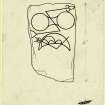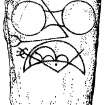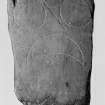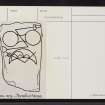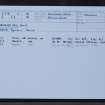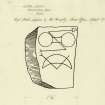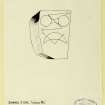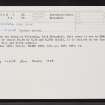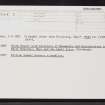Skye, Fiskavaig Bay
Pictish Symbol Stone (Pictish)
Site Name Skye, Fiskavaig Bay
Classification Pictish Symbol Stone (Pictish)
Alternative Name(s) Fiscavaig
Canmore ID 11078
Site Number NG33SW 3
NGR NG 330 340
Datum OSGB36 - NGR
Permalink http://canmore.org.uk/site/11078
- Council Highland
- Parish Bracadale
- Former Region Highland
- Former District Skye And Lochalsh
- Former County Inverness-shire
Fiscavaig, Skye & Lochalsh, Pictish symbol stone
Measurements: H 0.89m, W 0.52m, D 0.27m
Stone type: schist
Place of discovery: NG c330 340
Present location: National Museums Scotland (X.IB 213).
Evidence for discovery: found on the shore of Fiscavaig Bay around 1921 and left in situ until 1927, when it was sent to Edinburgh.
Present condition: the base is broken and the surface is very worn.
Description
One broad face of this slab bears two incised symbols: a double disc and Z-rod above a crescent and V-rod.
Date range: seventh century.
Primary references: RCAHMS 1928, no 498; Fisher 2001, 104; Fraser 2008, no 132.
Compiled by A Ritchie 2016
Note (1928)
Symbol Stone, Fiskavaig Bay.
Attention was drawn by Mr Murphy, Excise Officer, Carbost, to a symbol stone lying on the sea-shore at Fiskavaig Bay, and the slab has now been acquired by the National Museum of Antiquities of Scotland. It is incised on one face with the spectacle and floriated zig-zag rod and the crescent and floriated V-shaped rod symbols. The slab measures 3 feet in length and varies in breadth and thickness from 16 inches and 8 inches respectively at the bottom to 20 inches and 10 1/2 inches at the top. Cf. Proc. Soc. Ant. Scot., Vol. LXI.
RCAHMS 1928 No. 498
OS map: Skye xxxiii (unnoted).
Reference (1997)
Class I symbol stone bearing a double disc and Z-rod with a crescent and V-rod.
A.Mack 1997.
Reference (2001)
A symbol-stone was noted at high-water mark on the shore of Fiscavaig Bay, an inlet of Loch Bracadale, about 1921. After being concealed for some time by shingle it was rediscovered in 1927 and presented to the National Museum of Antiquities of Scotland (NMS X.IB 213) (1).
The stone is a slab of schist, 0.89m high and 0.27m thick and tapering in width from 0.52m at the top to 0.43m above the foot, which is broken obliquely. In the upper part there is a double-disc-and-Z-rod symbol. The discs are unornamented and the Z-rod has a foliated head at the upper right terminal, but a plain fork at the other one. Below this there is a crescent-and-V-rod symbol. The crescent encloses in the left half two unequal arches contained by a larger one, but the right half is worn and only one small arch can be traced. The right terminal of the V-rod has also been obliterated, but the other retains most of its foliation.
Footnote:
(1) J G Callander 1927a, 241. A sketch was sent to the Commission in 1921 by Mr Murphy, the excise officer who discovered the stone (NMRS, IND/65/3).
J G Callander 1927a, 241-3; RCAHMS 1928, No.498; R B K Stevenson 1955, C6, fig.15, 102-3; A Mack 1997, 33.
I Fisher 2001, 104.
Desk Based Assessment
NG33SW 3 33 34.
Found on the beach at Fiscavaig, Loch Bracadale, this stone is now in the National Museum of Antiquities of Scotland (NMAS, IB 213); a slab of schist (0.9m by 0.5m and 0.25m thick), it is incised on one face with double disc and Z-rod symbols.
Information from OS.
J G Callander 1927; RCAHMS 1928; 1985.














